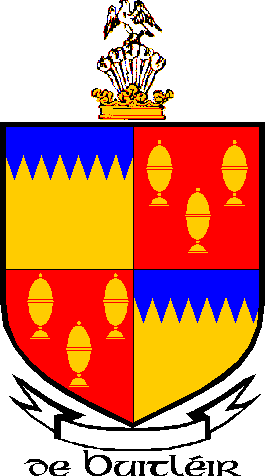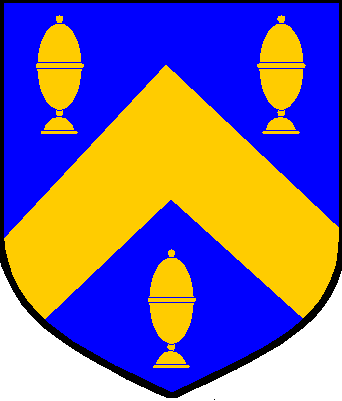Thomas
Dubh BUTLER
(10th E. Ormonde)
Children:
1. Elizabeth
BUTLER
2. James
BUTLER (1° V. Thurles)
Married 3: Helen
BARRY Jun 1601
Children:
3.
Piers
FitzThomas BUTLER of Duisk
4. Thomas
BUTLER (Sheriff of Tipperary) (d. 17 Jan 1605)
02_small.jpg)
Thomas
Butler, Earl of Ormonde
by
Stephen Van Der Meulen
Known as "Black Tom". Chief Butler of Ireland. 3° Earl of Ossory.
In 1543, James Butler, 9th Earl of Ormonde, had requested
Henry VIII to grant a place at court to his heir Thomas, whom
he despatched to court the next year. Already at court were two of Thomas’
first cousins, Lady Elizabeth Fitzgerald, daughter of the 9th Earl of
Kildare – immortalised by the poet
Thomas Surrey as ‘The Fair
Geraldine’ – and Barnaby Fitzpatrick,
son of the baron of Upper Ossory. Thomas and
Barnaby joined group of ten or
twelve noble youths whom Henry VIII
had selected to be educated with his son
Edward. While most of the other pupils changed in the course of the
years, the two cousins remained until the school group was formally disbanded in
autumn 1552, five years after Edward
had come to the throne. Upon the accession of
Edward VI, Thomas was made a
Knight of the Garter. Ormonde actually participated in the Christmas festivities that year
disguised as an ‘Almain’, or German. By 1552 Thomas had reached
his majority and succeeded to earldom of Ormond, his father having died of food
poisoning in London in 1546.
When Edward VI died in
Jul 1553, his catholic sister Mary
came to the throne, and Ormonde appears to have had no difficulty in
accommodating himself to the changed regime. Black Tom won his spurs and
possibly his nickname when suppressing the
rebellion against
Queen Mary of Sir Thomas Wyatt,
whom some called White Tom.
Mary retained the Earl at court for a further year, allowing him to
return to Ireland in Oct 1554, along with
Barnaby Fitzpatrick and Gerald
Fitzgerald, 11th Earl of Kildare. Throughout the rest of his long life,
Ormonde maintained his family’s tradition of unswerving loyalty to the crown,
spending long periods at court, where he exploited the powerful connections his
early education had given him.
Thomas
Butler lived a considerably long life for his time, and gained a respect that no
other man in Ireland would be able to obtain. He was considered to be an honest
and upstanding peer by those in Ireland and England. Queen Elizabeth considered
him to be a good friend and companion and trusted his opinion. Thomas made many enemies because of his honesty,
candor and the fact that the Queen favored him.
He was a great
strategist who had a standing army of Scot mercenaries called gallowglass. These
incredible soldiers where popular in Ireland and were often used like a common
commodity. Their brute strength and courageous tactics made them a formidable
enemy against the English at Cashel, and Killroe, serving O’Neil and massacred
an army of lanskanechts at the siege of Caracfergus. The Ormondes had kept an
army of these men for over a hundred years and found them to be very useful in
defending against the gallowglass of other factions. The MacSweeneys were in the
Ormonde’s employ and cost a great deal of money to maintain. One thing was for
sure: they were worth the money as almost every English noble that came with
their armies to wipe out Irish rebels called upon Ormonde for the support or
protection of his armies.
A very
proficient diplomat, Thomas was responsible for swaying a great many rebels,
including Hugh O’Neil, to swear to treaties of loyalty to the Crown.
Ormonde
was not the only person responsible for that act; O’Neil followed the
suggestions of both Henry Sidney and the
Earl Ormonde for they were the two
English men for whom he held the highest respect. Thomas held a seat on the
Privy Councils of both England and Ireland, and worked hard at stimulating the
economy on his lands. He even went so far as to grant right of travel for young
Irish boys to Bristol as apprentices in the hopes that they would return to
Ireland as master tradesmen.
Ormonde,
like his father continued to harbor aggressions with his neighbor and fellow
countryman the Earl Desmond, as part of a hostile four-generation feud between
the Geraldines (Desmond and kin) and the Butlers (Ormonde and kin).
After the death of his mother, the Countess of Desmond, the old feud
between the Butlers and Geraldines broke out again and Black Tom defeated
the Earl of Desmond at the Battle of Affane in 1565, the last private
pitched battle fought on the soil of the British Isles. These
disputes ranged from issues of Loyalty to those of property right, boundary
lines, policy, strategy and anything else that they could use to make peace a
difficult solution. Finally in 1568,
Desmond is thrown in the tower and must
stay there for six years. In 1574 he is released and is to turn himself in to
the jail in Dublin where he is allowed to escape and turns Rebel. Thomas,
however, is not too distraught over this as he is in control of a fair amount of
it in Desmond’s absence.
01_small.jpg)
Thomas
Butler, Earl of Ormonde
Detail
of Elizabeth in procession to Blackfriars in 1600
In the style of Peake
In a private collection
Ormonde
and Queen Elizabeth met in London as children;
Thomas the "son of an Irish
Earl" and Elizabeth the "illegitimate daughter of Henry"
shared a common ground as neither was well treated by the other young nobles in
court. They were related through her mother
Anne Boleyn. Elizabeth
called him her ‘black husband’. In 1588 the
Queen bestowed on Ormond what an Irish poet described as 'áirdchéim
Ridireacht Gáirtéir, / ainm nár ghnáth é ar Éirionnach' (‘the high honour
of Knighthood of the Garter, a title rare on an Irishman’).
Ormonde
built a Tudor style castle (Carrick on Suir) along the river Sui, which he
decorated lavishly and even had red brick chimneys built on, which, at the time,
were very expensive. All of this was for one reason; to provide Elizabeth with a
suitable palace at which to stay when she traveled to Ireland. Thomas lived
eleven years after Elizabeth died and during her entire reign she never once set
foot in Ireland.
Married
three times, Thomas produced four children, three boys and one girl. One boy
died at birth; the other two die as young adults and his daughter Elizabeth
lived to be in her fifties. He had had at least 12 illegitimate children. Ormonde spent most of his time in England in the
presence of the Queen and many rumors were issued as to the matter.
In 1614
Thomas died in his bed shortly after Christmas,
in the Elizabethan manor he had built at Carrick, with the blue ribbon of the Order
of the Garter around his neck, as it was every night since it was given to him.
He was buried in St Canice's. His Will so favoured his eldest illegitimate son, Piers, as to
suggest that the mother of Piers of Duisk was someone of great
importance. Indeed, there is not lacking circumstantial evidence
to support the persistent and rather startling rumor that the
Virgin Queen bore him Piers Butler of Duiske, the father of
Edmund, 1st Viscount Galmoy.
Towards the end of 1553 she had the opportunity to conceive Piers Butler;
in Feb 1554 she was said to be pregnant at Ashridge. In May, when offered
physicians at Woodstock, she announced: "I am not minded to make any stranger
privy to the state of my body but commit it to God".

02_small.jpg)
01_small.jpg)



